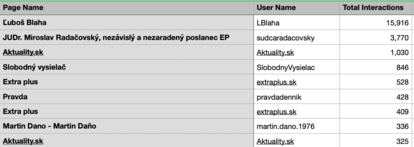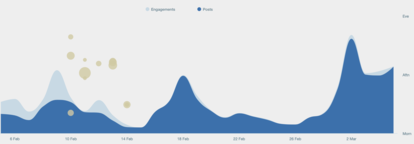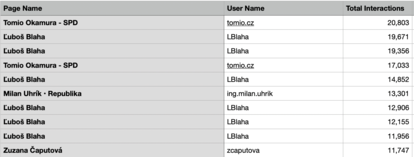By Friedrich Naumann Foundation for Freedom and STRATPOL – Strategic Policy Institute
Project Infosecurity.sk organized by STRATPOL – Strategic Policy Institute and Slovak Security Policy Institute, supported by the Prague office of Friedrich Naumann Foundation for Freedom, continuously monitors the activities of both Slovak and foreign disinformation actors, but focuses mainly on the former.
The project activities are built upon daily monitoring of emerging disinformation, hoaxes and conspiracy theories in the online information space. That allows the analysts to identify disinformation posts and narratives that resonated with the public the most, as well as to find out where they originated, and how they spread and evolved on social media.
This report represents a bi-weekly summary of arising trends in the spread of malicious information content online. Based on that, Infosecurity.sk can warn the public about emerging and current trends in the field of disinformation, manipulation, and propaganda.
In the last two weeks, Infosecurity.sk has managed to capture the following trends:
1. The disinformation narratives revolved primarily around resonating topics in society, such as the purchase of the Sputnik V vaccine by Slovakia and the Navalnyj case
2. Russia did not hesitate to utilise Sputnik V as a tool of hybrid warfare to fuel euro-sceptic sentiments and further polarise the society
3. The pro-Kremlin media has also spread a wide range of fabricated conspiracy theories with a common goal of diverting attention from Navalnyj’s political trial and delegitimising the ongoing opposition protests
4. Data collected by using CrowdTangle and Pulsar tools indicate that the disinformation websites were remarkably successful in attracting the public’s attention using fabricated conspiracy narratives
5. Russia did not hesitate to use its embassy in Slovakia as a medium for spreading false information and propaganda.
Twisting the Truth Around the Navalnyj Case
In late January, the Anti-Corruption Fund, founded by Russian opposition leader Alexei Navalnyj released an online documentary detailing President Vladimir Putin’s alleged corruption schemes and a private luxury mansion on the coast of the black sea. The nearly two-hour-long documentary caused an uproar in Russia, where it sparked a wave of anti-government protests. It also managed to attract significant attention abroad and Slovakia was no exception.
Following the documentary’s release, the pro-Kremlin media unleashed a relentless smear campaign against Navalnyj’s persona as well as against the protests the documentary had triggered. The smear campaign reached as far as Slovakia, where Infosecurity.sk recorded an increase (here, here, here, and here) in the spread of pro-Kremlin conspiracy narratives targeting the opposition leader.
The most active in spreading the disinformation was a well-known group of local pro-Kremlin websites. In the past, the group was identified as spreading a wide range of misinformation and conspiracy theories, which always ran in line with the Russian state propaganda. Several pro-Russian Slovak politicians, such as Ľuboš Blaha (a Slovak opposition MP) have also actively participated in the smear campaign.
In addition to repeatedly claiming that the poisoning of Navalnyj never happened, the pro-Russian media have actively tried to raise questions about Navalnyj’s allegiance by creating fake conspiracy theories claiming that he was an agent of foreign secret service. According to these claims, Navalnyj was a puppet used by the West to overthrow the Russian government.
In some cases, however, the conspiracy narratives spread by the disinformation actors contradicted each other. For instance, an article citing pro-Kremlin politician Sergei Kurginjan claimed that Navalnyj was not a CIA agent but a fraudster and a criminal from the “Kremlin elite”. This points to the fact that the pro-Kremlin media have not only spread a single collective narrative but several different ones with the common goal to discredit Navalnyj in any possible way.
The pro-Kremlin media have been especially attracted to the fact that most of the EU Member States have been vocal in expressing their criticism of the fabricated political trial with Navalnyj. Such criticisms of human rights violations were interpreted as a manifestation of “Russophobia” and an attempt to interfere in Russia’s domestic affairs.
Following this reasoning, the pro-Russian media have concluded that the online documentary was nothing more than a propaganda operation and a tool utilised by the west to attack Russia. Thus, the pro-Russian media have deliberately attempted to portray Kremlin as a victim while depicting the EU and the West as aggressors.
In this regard, the disinformation actors have also targeted the pro-European, liberal President of Slovakia, Zuzana Čaputová, accusing her of defending a fraudster and a criminal. The reason for this being her strong condemnation of the political process with Navalnyj in line with the EU’s position.
The disinformation actors have also made repeated efforts to challenge the claims presented in Navalnyj’s documentary. Paradoxically, with a narrative claiming that the documentary’s findings are nothing more than an unfounded conspiracy.
Simultaneously, the pro-Russian media were deliberately downplaying the importance and strength of the anti-government protests and defending the repressions against the protesters by the security forces. In this context, they made several references to comments made by the Kremlin spokesman Dmitry Peskov, who advocated using brute force against the protesters and to a post by Jan Čarnogurský (former PM of Slovakia), in which he claimed that Putin’s support had not fallen despite the protests.
In general, the disinformation actors presented a view in which they portrayed the Kremlin as a victim of an attack while downplaying the reprisals faced by the Russian opposition.
Based on the data gathered using CrowdTangle[1], Infosecurity.sk observed that over the last 30 days, the disinformation actors have been notably successful in reaching their audience. As many as 6 out of 9 posts involving news about Navalnyj, which scored the highest number of interactions, came from disinformation actors. Aktuality.sk and Pravda are regular newspapers and are the only media on the list that can be classified as relevant and trustworthy sources.
Most of the other sources in the sheet are personal Facebook profiles that have been proven to spread disinformation and malicious content in the past. The profile of Ľuboš Blaha ranked first in the total scored interactions. Blaha is a far-left-leaning Slovak opposition MP who defends the annexation of Crimea by Russia and is known to spread pro-Kremlin propaganda on his blog regularly.
The data was obtained by searching the keyword “Navaľnyj”.

To summarise, the disinformation media have published many articles containing conspiracy narratives with a pro-Russian sentiment. These articles’ common goal was to divert attention from Navalnyj’s political trial and delegitimise the ongoing protests by presenting a narrative that the protests are not a manifestation of legitimate anger at corrupt Kremlin elites but a result of a planned foreign-led operation.
Sputnik V as a Tool of Hybrid Warfare
A highly disputed topic of recent days has been the purchase of the Russian unregistered vaccine Sputnik V by Slovakia. The ambiguities surrounding its purchase and uncertainties related to its safety have polarised the government coalition and the general public. The polarized situation resulted in an opportunity for the disinformation outlets to flood the information space with a variety of misleading articles.
Especially before the European Medicines Agency (EMA) started the rolling review of the vaccine, it was heatedly debated whether to purchase and use the vaccine despite it not being approved by the EU institutions.
In the debate, the Embassy of the Russian Federation in Slovakia has embarked on a journey of spreading disinformation. It made a post on Facebook and Twitter claiming that an official application for vaccine approval had been submitted. However, the EMA, tasked with approving vaccines, did not receive any such application.
Furthermore, the Russian Embassy’s screenshot that was to prove that the application has been sent made reference to HMA — ‘Heads of Medicines Agencies’ instead of the EMA. HMA, however, has nothing to do with vaccine registration. The Russian embassy’s claims have thus proved misleading.
Nonetheless, the Russian embassy continued to mislead the public further. A few days later, it made a post on social media quoting a statement made by Vladimir Putin. In the statement, Putin defended Sputnik V as the most effective and safest vaccine in the world. In addition to the biased arguments in Sputnik’s favour, Putin also made unsubstantiated claims that some European countries were forced to stop vaccinating with Pfizer/BioNTech vaccines after deaths occurred after their use.
The pro-Russian websites have also been actively spreading disinformation on this topic. Following an example of the Russian state propaganda, their articles were characterised by a unilateral biased arguing in favour of the Sputnik V vaccine. In this context, a Slovak disinformation website Hlavný denník cited an interview with a Russian doctor who, with a substantially strong bias towards the Russian vaccine, compared Sputnik V with Pfizer vaccines.
Unsurprisingly, announcing that Sputnik V is a clear winner. Consequently, the pro-Russian websites wrote about Western vaccines predominately in a negative light while attributing only positive qualities to Sputnik V.
The disinformation campaign also targeted the EU. The conspiracy sites, quoting Russian Foreign Minister Sergei Lavrov, claimed that the requirement for an EU control registration of the vaccine is a geopolitical game. According to his narrative, the registration requirement is a proof of the EU’s bias against Russia, which itself is a result of the U.S. influence.
As in the Navalnyj case, the disinformation actors actively sought to divert the public’s attention from topics that may harm the Kremlin’s image, such as the lack of transparency surrounding Sputnik V’s development. To do this, they once again shifted the blame on the West and made frequent use of the “Russophobe” card against anyone who had legitimate reservations about the vaccine’s purchase.
Consequently, in both the Navalnyj and Sputnik cases, we can observe a trend in categorising Russia as a victim while denoting the opposition as “Russophobes”. In practical terms this means that any constructive criticism of the Sputnik V vaccine is labelled as being automatically false, and the pro-Russian media avoid sensitive questions related to its safety.
It is apparent that Russia and its disinformation proxies are trying to make the most out of Slovakia’s ongoing political crisis triggered by the vaccine’s purchase. Russia did not hesitate to utilise Sputnik V as a tool of hybrid warfare to fuel euro-sceptic sentiments and polarise the public. This is observable in the frequent use of its embassy’s social media to spread disinformation and releasement of content that supports pro-Russian websites’ conspiracy claims.
The fact that Sputnik V’s purchase by Slovak Prime Minister Igor Matovič, who bought the vaccine in spite of demands from his coalition partners not to use the Russian vaccine until it is registered by the EMA, triggered wider discussions about the vaccine in Slovakia and the Czech Republic is shown in the graph from the tool Pulsar[2].

The graph indicates that the word “Sputnik” appeared in the Slovak and Czech media significantly more often during the vaccine’s arrival to Slovakia than before.
The data gathered using CrowdTangle illustrate that conspiracy websites scored the most interactions with the public during this period. The first 9 out of 10 shown pages on the list are known for periodically spreading false information on their Facebook profiles.
In the total amount of interactions, the personal profile of a far-right Czech opposition MP, Tomio Okamura, is only second to that of the far-left leaning Ľuboš Blaha, who also scored high. Milan Uhrík is another Slovak far-right extremist politician whose profile interactions were among the top. Uhrík was elected as a member of the European Parliament in 2019 and just recently left the far-right extremist People’s Party Our Slovakia to establish his own. The Facebook profile of the Slovak president Zuzana Čaputová is the only trustworthy source on the list.
The data was obtained by searching the keyword “Sputnik”.

[1] CrowdTangle is a tool from Facebook to help follow, analyze, and report on what’s happening across social media. https://www.crowdtangle.com
[2] Pulsar is a social listening and audience intelligence platform. https://www.pulsarplatform.com
This report has been prepared with support from IRI’s Beacon Project. The opinions expressed are solely those of the author and do not reflect those of IRI
The article was originally published at: https://www.freiheit.org/central-europe-and-baltic-states/infosecuritysk-bi-weekly-report-emerging-disinformation-trends
Written by:
Matej Spišák – a Research Fellow at STRATPOL – Strategic Policy Institute in Bratislava and Editor-in-Chief at Infosecurity.sk
Denis Takács – an Analyst at STRATPOL – Strategic Policy Institute in Bratislava
Continue exploring:
Sense of Freedom in Hungary During COVID-19 Pandemic
Death by Thousand Cuts: Erosion of Media Independence in Poland



